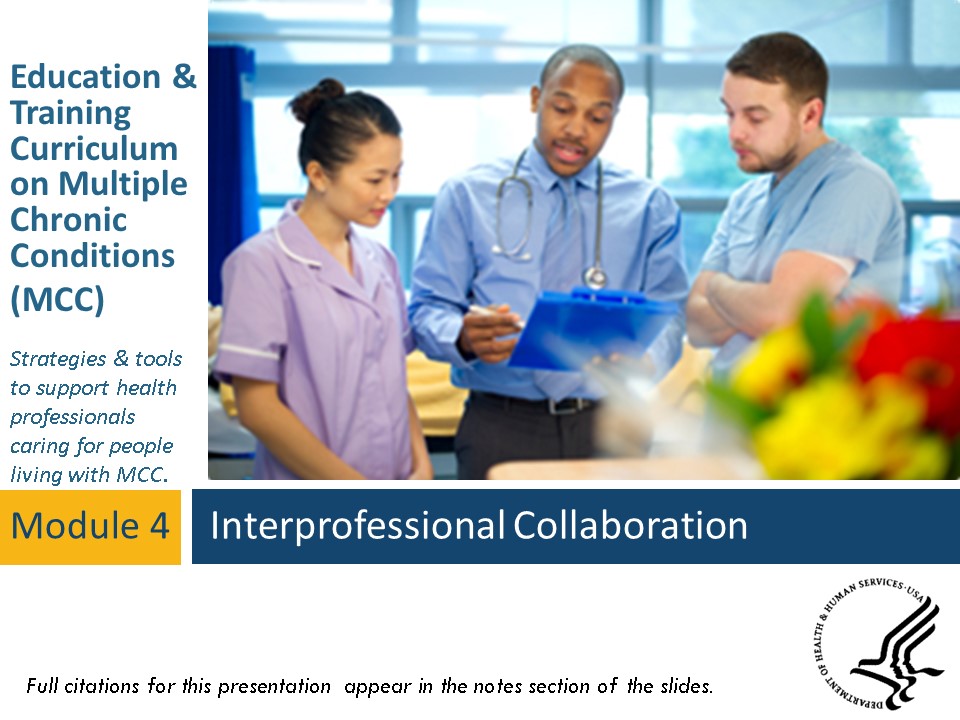Interprofessional Collaboration - PowerPoint PPT Presentation
Title:
Interprofessional Collaboration
Description:
Teams strive to be actively interdependent and work through established means of communication to ensure ... care management model for ... project. Acad Med, 88(12 ... – PowerPoint PPT presentation
Number of Views:752
Avg rating:3.0/5.0
Title: Interprofessional Collaboration
1
Interprofessional Collaboration
Education Training Curriculum on Multiple
Chronic Conditions (MCC) Strategies tools to
support health professionals caring for people
living with MCC.
Module 4
Full citations for this presentation appear in
the notes section of the slides.
2
Learning Objectives for this module
- After completing this module, you will be able
to - Articulate why Interprofessional Collaboration
(INTER) is beneficial to persons living with
multiple chronic conditions (PLWMCC) - Apply INTER strategies for continuity of care
for PLWMCC across settings
3
Overview of Contents in this module
- How interprofessional collaboration helps PLWMCC
- Components of an effective interprofessional
collaboration - Putting interprofessional collaboration into
practice
4
Section 1
- How Interprofessional Collaboration Helps PLWMCC
5
Interprofessional Collaboration (INTER)
Definition The ability of healthcare and other
professionals, as well as direct care providers,
community health workers, persons living with MCC
(PLWMCC), families and caregivers, to work
effectively within and between professions and
with PLWMCC, families, caregivers, and
communities to provide appropriate and effective
healthcare.
6
INTER Competencies
7
INTER Competencies (Continued)
8
Benefits for using INTER
- For Clinicians
- For PLWMCC
- Improves productivity of the team
- Creates synergy between team members
- Makes resources available to PLWMCC
- Improved quality of care
- Safer and more effective healthcare system
- Higher satisfaction
9
Section 2
- Components of an Effective Interprofessional
Collaboration
10
Members of an interprofessional team
11
Effective interprofessional teams
- Clear understanding of roles required tasks
- Shared leadership
- Established means of communication
- Prioritizes activities based on PLWMCCs
preferences and severity of health conditions - Work collaboratively to optimize outcomes
- Allows all members to practice at the top of
their licenses - Share common goals
Components
12
Section 3
- Incorporating Interprofessional Collaboration
into Practice
13
Models that Utilize Interprofessional Teams
14
Opportunities to Integrate INTER into Practice
15
The Role of PLWMCC on Interprofessional Teams
- Serve as a core member of the team
- Provide input into their health concerns, goals
and strategies - Monitor their care plans and communicate with all
members of the team
16
Care Planning Interprofessional Team Approach
- Living documents
- Developed with input by all members of the team
including PLWMCC - Accessible by all team members revised regularly
17
Interprofessional Teams and Community Linkages
- Improves PLWMCC access to community resources and
support - Offers augmented interventions and services
- Increases care for PLWMCC
Ongoing clear and consistent communication is
central!
18
Barriers Solutions to INTER
- Barriers/Challenges
- Solutions
- Unplanned visits with unrealistic agendas
- Inadequate support to meet the PLWMCCs need for
care - Insufficient time for documenting and complying
with administrative requirements
- Schedule previsit planning
- Share the care among the team and expand
responsibility of select team members - Sharing clerical tasks collaboratively and
employing scribing
19
Barriers Solutions to INTER (Continued)
- Barriers/Challenges
- Solutions
- Poor communication
- Team meetings are too time-consuming.
- Computerized technology that causes more work for
physicians
- Establish workflow mapping and new systems
planning - Schedule huddles or regular team meetings
- Utilize in-box management and verbal messaging
20
INTER Resources
- An Interprofessional Approach to Chronic
Conditions Module 5 Caregiver and Family Support
in Managing Chronic Conditions
http//www.pogoe.org/productid/20651 - Interprofessional Standardized Patient Exercise
(ISPE) The Case of Elsie Smith
www.mededportal.org/publication/9507 - HHS MCC Education and Training Repository
http//www.hhs.gov/ash/initiatives/mcc/educational
resources

